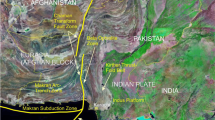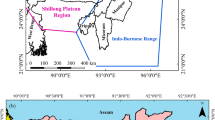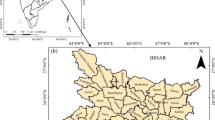Abstract
The present study aims at understanding the seismotectonic province of the Shillong Plateau (SP) by identifying the potential seismic source zones within a radius of 500 km from the centre of the SP. From existing literature and earthquake (EQ) data, the seismotectonic region is found to vary in terms of seismicity, tectonic features, geology, thickness of overburden, rupture characteristics and rate of movement. Thus, entire 500-km-radius seismotectonic region is divided into four seismic source zones: namely (1) the Shillong Plateau–Assam Valley Zone (SP-AVZ), (2) the Indo-Burma Ranges Zone (IBRZ), (3) the Bengal Basin Zone (BBZ) and (4) the Eastern Himalaya Zone (EHZ). EQ catalogues for each source zone is analysed for completeness of magnitude and time. Seismic parameter b estimated using a maximum likelihood method is found to be 0.91 ± 0.03, 0.94 ± 0.02, 0.80 ± 0.03 and 0.89 ± 0.03 for the SP-AVZ, IBRZ, BBZ and EHZ, respectively. In addition, the maximum likelihood method is used to estimate the mean annual activity rate, maximum possible magnitude (m max), return period and probability of exceedance for the four zones. The b values estimated suggest that the BBZ is seismically more active; however, the rate of occurrence of EQs is highest in the IBRZ. Findings from this study are an indication of the relative contribution from each of the four seismic source zones towards a seismic hazard of the SP.







Similar content being viewed by others
References
Anbazhagan P, Kumar A, Sitharam TG (2013a) Ground motion prediction equation considering combined dataset of recorded and simulated ground motions. Soil Dyn Earthq Eng 53:92–108. doi:10.1016/j.soildyn.2013.06.003
Anbazhagan P, Smitha CV, Kumar A, Chandran D (2013b) Estimation of design basis earthquake using region-specific Mmax, for the NPP site at Kalpakkam, Tamil Nadu, India. Nucl Eng Des 259:41–64. doi:10.1016/j.nucengdes.2013.02.047
Anbazhagan P, Bajaj K, Patel S (2015) Seismic hazard maps and spectrum for Patna considering region-specific seismotectonic parameters. Nat Hazards 78:1163–1195. doi:10.1007/s11069-015-1764-0
Angelier J, Baruah S (2009) Seismotectonics in Northeast India: a stress analysis of focal mechanism solutions of earthquakes and its kinematic implications. Geophys J Int 178:303–326. doi:10.1111/j.1365-246X.2009.04107.x
Banerjee P, Bürgmann R, Nagarajan B, Apel E (2008) Intraplate deformation of the Indian subcontinent. Geophys Res Lett 35:1–5. doi:10.1029/2008GL035468
Baranowski J, Armbruster J, Seeber L (1984) Focal depths and fault plane solutions of earthquakes and active tectonics of the Himalaya. J Geophys Res 89:6918–6828
Baro O, Kumar A (2015) A review on the tectonic setting and seismic activity of the Shillong Plateau in the light of past studies. Disaster Advances 8(7):34–45
Bilham R (2004) Earthquakes in India and the Himalaya: tectonics, geodesy and history. Ann Geophys 47(2):839–858. doi:10.4401/ag-3338
Bilham R, England P (2001) Plateau pop-up during the 1897 Assam earthquake. Nature 410(6830):806–809
Chen WP, Molnar P (1990) Source parameters of earthquakes and intraplate deformation beneath the Shillong Plateau and the northern Indoburman ranges. J Geophys Res 95:12527–12552
Choudury JR (1993) Bangladesh—seismicity in Bangladesh. Incede Report, Bangkok
Christophersen A, Gerstenberger MC, Rhoades DA, Stirling MW (2011) Quantifying the effect of declustering on probabilistic seismic hazard. Proceedings of the ninth Pacific conference on earthquake engineering
CNDM (2002) Scenario of seismic hazard in Assam. A report by the Assam Administrative Staff College, Guwahati, Assam, India
Curray JR, Emmel FJ, Moore DG, Raitt RW (1982) Structure, tectonics, and geological history of the northeastern Indian Ocean, in the Indian Ocean. In: Nairn AEM, Stehli FG (eds) The ocean basins and margins, vol 6. Plenum, New York, pp 399–450
Das S, Gupta ID, Gupta VK (2006) A probabilistic seismic hazard analysis of Northeast India. Earthquake Spectra 22(1):1–27
Gan W, Zhang P, Shen ZK, Niu Z, Wang M, Wan Y et al (2007) Present-day crustal motion within the Tibetan Plateau inferred from GPS measurements. J Geophys Res Solid Earth 112:1–14. doi:10.1029/2005JB004120
Gee ER (1934) The Dhubri earthquake of the 3rd July 1930. Memoir Geol Surv India 65(1):1–106
Gen-ru X, Gan W-j, Chen W-t, Cheng J (2010) Present-day movement of Bangong co-Nujiang suture zone, Tibetan Plateau, inferred from GPS measurements. J4 40(6):1496–1502
Goswami HC, Sarmah SK (1982) Probabilistic earthquake expectancy in the Northeast Indian region. Bull Seismol Soc Am 72:999–1009
Gupta ID (2002) The state of the art in seismic hazard analysis. ISET J Earthq Technol 39(4):311–346
Gutenberg B, Richter CF (1956) Magnitude and energy of earthquakes. Ann Geofis 9:1–15
Holt WE, Ni F, Wallace C, Haines AJ (1991) The active tectonics of the Eastern Himalayan syntaxis and surrounding regions. J Geophys Res 96:14, 595–14, 632
IMD, Indian Meteorological Department, http://www.imd.gov.in/pages/earthquake_prelim.php. Accessed 6 May 2016
Jade S, Mukul M, Bhattacharyya AK, Vijayan MSM, Jaganathan S, Kumar A et al (2007) Estimates of interseismic deformation in Northeast India from GPS measurements. Earth Planet Sci Lett 263:221–234. doi:10.1016/j.epsl.2007.08.031
Jena AK, Haldia BS, Solomon R, Sahoo AK, Bhanja AK, Samanta A (2012) Exploration strategy in Tripura fold belt, Assam & Assam Arakan Basin, India—some contemporary approach. 9th Biennial international conference & exposition on petroleum geophysics, Hyderabad
Kagan YY (2002) Seismic moment distribution revisited: I. Statistical results. Geophys J Int 148:521–542
Kayal JR (2008) Microearthquake seismology and seismotectonics of South Asia. McGraw Hill, India
Kayal JR (2014) Seismotectonics of the great and large earthquakes in Himalaya. Curr Sci 106(2):188–197
Kayal JR, Arefiev SS, Baruah S, Tatevossian R, Gogoi N, Sanoujam M et al (2010) The 2009 Bhutan and Assam felt earthquakes MW (6.3 and 5.1) at the Kopili fault in the northeast Himalaya region. Geomatics, Nat Hazards Risk 1:273–281. doi:10.1080/19475705.2010.486561
Kijko A, Graham G (1998) Parametric-historic procedure for probabilistic seismic hazard analysis. Part I: estimation of maximum regional mmax. Pure Appl Geophys 152(3):413–442
Kijko A, Smit A, Sellevoll MA (2016) Estimation of earthquake hazard parameters from incomplete data files. Part III. Incorporation of uncertainty of earthquake-occurrence model. Bull Seismol Soc Am 106(3):1210–1222. doi:10.1785/0120150252
Krishna MR, Sanu TD (2000) Seismotectonics and rates of active crustal deformation in the Burmese arc and adjacent regions. J Geodyn 30:401–421. doi:10.1016/S0264-3707(99)00074-5
Kumar A, Baro O (2016) In-direct estimation of local soil response in the light of past as well as recent earthquakes in the Shillong Plateau. In: Proceeding of the Indian geotechnical conference IIT Madras, Chennai, India
Kumar A, Anbazhagan P, Sitharam TG (2013) Seismic hazard analysis of Lucknow considering local and active seismic gaps. Nat Hazards 69:327–350. doi:10.1007/s11069-013-0712-0
Kumar A, Baro O, Harinarayan NH (2016) Obtaining the surface PGA from site response analyses based on globally recorded ground motions and matching with the codal values. Natural Hazards 81(1):543–572
Kumar D, Reddy DV, Pandey AK (2016) Paleoseismic investiga- 1201 tions in the Kopili fault zone of North East India: evidences 1202 from liquefaction chronology. Tectonophysics 674:65–75. doi:10.1016/j.tecto.2016.02.016
Kumar A, Harinarayan NH, Baro O (2017) Nonlinear soil response to ground motions during different earthquakes in Nepal, to arrive at surface response spectra. Nat Hazards. doi:10.1007/s11069-017-2751-4
Kundu B, Gahalaut VK (2013) Tectonic geodesy revealing geodynamiccomplexity of the Indo-Burmese arc region, North East India. Curr Sci 104(7):920–933
Marzocchi W, Sandri L (2003) A review and new insights on the estimation of the b-value and its uncertainty. Ann Geophys. doi:10.4401/ag-3472
Maurin T, Rangin C (2009) Structure and kinematics of the Indo-Burmese wedge: recent and fast growth of the outer wedge. Tectonics 28:1–21. doi:10.1029/2008TC002276
Mittal H, Kumar A, Ramhmachhuani R (2012) Indian national strong motion instrumentation network and site characterization of its stations. Int J Geosci 3:1151–1167. doi:10.4236/ijg.2012.326117
Mohanty WK, Walling MY (2008) Seismic hazard in mega city Kolkata, India. Nat Hazards 47:39–54. doi:10.1007/s11069-007-9195-1
Mohanty WK, Verma AK, Vaccari F, Panza GF (2013) Influence of epicentral distance on local seismic response in Kolkata City, India. J Earth Syst Sci 122:321–338. doi:10.1007/s12040-013-0275-1
Morino M, Kamal ASMM, Ali RME, Talukder A, Khan MH (2013) Report of active faultmapping in Bangladesh: paleo-seismological study of the Dauki fault and the Indian-Burman plate boundary fault; Comprehensive disaster management program, Ministry of Disaster Management and Relief
Mukhopadhyay B (2011) Clusters of moderate size earthquakes along Main Central Thrust (MCT) in Himalaya. Int J Geosci 02:318–325. doi:10.4236/ijg.2011.23034
Mukhopadhyay B, Dasgupta S (2015) Earthquake swarms near Eastern Himalayan syntaxis along Jiali fault in Tibet: a seismotectonic appraisal. Geosci Front 6:715–722. doi:10.1016/j.gsf.2014.12.009
Nandy DR (2001) Geodynamics of Northeastern India and the adjoining region. ABC, Kolkata
Nath SK, Thingbaijam KKS, Raj A (2008) Earthquake hazard in the Northeast India. A seismic microzonation approach with typical case studies from Sikkim Himalaya and Guwahati City. J Earth Syst Sci 117(S2):809–831
Nath SK, Raj A, Thingbaijam KKS, Kumar A (2009) Ground motion synthesis and seismic scenario in Guwahati City—a stochastic approach. Seismol Res Lett 80:233–242
Nath SK, Adhikari MD, Maiti SK, Devaraj N, Srivastava N, Mohapatra LD (2014) Earthquake scenario in West Bengal with emphasis on seismic hazard microzonation of the city of Kolkata, India. Nat Hazards Earth Syst Sci 14:2549–2575. doi:10.5194/nhess-14-2549-2014
National Disaster Management Authority (NDMA) (2010) Development of probabilistic seismic hazard map of India. Technical report by National Disaster Management Authority, Government of India
Ni J, Barazangi M (1984) Seismotectonics of the Himalayan collision zone: geometry of the underthrusting Indian plate beneath the Himalaya. J Geophys Res 89:1147–1163. doi:10.1029/JB089iB02p01147
Oldham T (1882) The Cachar earthquake of 10th January, 1869, by the late Thomas Oldham edited by Oldham RD. Memoir Geol. Surv. India 19:1–98
Oldham RD (1899) Report on the great earthquake of 12 June 1897. Memoir Geol Surv India 29:1–379
Pallav K, Raghukanth STG, Singh KD (2012) Probabilistic seismic hazard estimation of Manipur, India. J Geophys Eng 9:516–533. doi:10.1088/1742-2132/9/5/516
Parvez IA, Ram A (1997) Probabilistic assessment of earthquake hazards in the North-East Indian Peninsula and Hindukush regions. Pure Appl Geophys 149:731–746. doi:10.1007/s000240050049
Paul J, Burgmann R, Gaur VK, Bilham R, Larson KM, Ananda MB, Jade S, Mukal M, Anuparna TS, Satyal G, Kumar D (2001) The motion and active deformation of India. Geophys Res Lett 28(4):647–650. doi:10.1029/2000GL011832
Raghukanth STG, Dash SK (2010) Deterministic seismic scenarios for Northeast India. J Seismol 14:143–167
Raghukanth STG, Iyengar RN (2006) Seismic hazard estimation for Mumbai City. Curr Sci 91(11):1486–1494
Rajendran CP, Rajendran K, Duarah BP, Baruah S, Earnest A (2004) Interpreting the style of faulting and paleoseismicity associated with the 1897 Shillong, Northeast India, earthquake: implications for regional tectonism. Tectonics 23:1–12. doi:10.1029/2003TC001605
Reasenberg PA (1985) Second order moment of central California seismicity, 1969-1982. J Geophys Res 90:5479–5495
Ristau J, Rogers GC, Cassidy JF (2005) Moment magnitude-local magnitude calibration for earthquakes in western Canada. Bull Seismol Soc Am 95:1994–2000. doi:10.1785/0120050028
Scordilis EM (2006) Empirical global relations converting MS and mb to moment magnitude. J Seismol 10:225–236. doi:10.1007/s10950-006-9012-4
SEISAT (2000) Seismotectonic atlas of India and its environs. Geological Survey of India, India
Shanker D, Sharma M (1998) Estimation of seismic hazard parameters for the Himalays and its viscinity and complete data files. Pure Appl Geophys 152:267. doi:10.1007/s000240050154
Sharma M, Malik S (2006) Probabilistic seismic hazard analysis and estimation of spectral strong ground motion on bed rock in north east India. International conference on earthquake engineering, Taipei, Taiwan
Sikder A, Alam M (2003) 2-D modelling of the anticlinical structures and structural development of the eastern fold belt of the Bengal Basin, Bangladesh. Sediment Geol 155:179–208. doi:10.1016/S0037-0738(02)00181-1
Sil A, Sitharam TG, Kolathayar S (2013) Probabilistic seismic hazard analysis of Tripura and Mizoram states. Nat Hazards 68:1089–1108. doi:10.1007/s11069-013-0678-y
Sitharam TG, Sil A (2014) Comprehensive seismic hazard assessment of Tripura and Mizoram states. J Earth Syst Sci 123:837–857. doi:10.1007/s12040-014-0438-8
Socquet A, Vigny C, Chamot-rooke N, Simons W, Rangin C, Ambrosius B (2006) India and Sunda plates motion and deformation along their boundary in Myanmar determined by GPS. J Geophys Res 111:1–11. doi:10.1029/2005JB003877
Srinivasan V (2003) Deciphering differential uplift in Shillong Plateau using remote sensing. J Geol Soc India 612:773–777
Srivastava HN, Verma M, Bansal BK, Sutar AK (2013) Discriminatory characteristics of seismic gaps in Himalaya. Geomatics, Nat Hazards Risk 6:224–242. doi:10.1080/19475705.2013.839483
Stein S, Geller RJ, Liu M (2012) Why earthquake hazard maps often fail and what to do about it. Tectonophysics 562-563:1–25. doi:10.1016/j.tecto.2012.06.047
Stepp JC (1972) Analysis of completeness of the earthquake sample in the Puget sound area and its effect onstatistical estimates of earthquake hazard. In: Proceeding of the International conference on microzonation, Seattle, USA, vol 2. 897–910
Tavakoli B, Ghafory-Ashtiany M (1999) Seismic hazard assessment of Iran. Ann Geophys 42:1013–1021. doi:10.4401/ag-3781
Thingbaijam KKS, Nath SK (2008) Estimation of maximum earthquakes in Northeast India. Pure Appl Geophys 165(5):889–901. doi:10.1007/s00024-008-0334-8
USGS, United States Geological Survey, http://earthquake.usgs.gov/earthquakes/search/. Accessed 6 May 2016
Vere-Jones D, Robinson R, Yang WZ (2001) Remarks on the accelerated moment release model: problems of model formulation, simulation and estimation. Geophys J Int 144:517–531
Vernant P, Bilham R, Szeliga W, Drupka D, Kalita S, Bhattacharyya AK, Gaur VK, Pelgay P, Cattin R, Berthet T (2014) Clockwise rotation of the Brahmaputra Valley relative to India: tectonic convergence in the Eastern Himalaya, Naga Hills, and Shillong Plateau. Journal of Geophysical Research: Solid Earth 119(8):6558–6571. doi:10.1002/2014JB011196
Wang Y, Sieh K, Tun ST, Lai K-Y, Myint T (2014) Active tectonics and earthquake potential of the Myanmar region. Journal of Geophysical Research: Solid Earth 119:3767–3822. doi:10.1002/2013JB010762
Wells DL, Coppersmith KJ (1994) New empirical relationships among magnitude, rupture length, rupture width, rupture area, and surface displacement. Bull Seismol Soc Am 84(4):974–1002
Wiemer S, Wyss M (2000) Minimum magnitude of completeness in earthquake catalogs: examples from Alaska, the Western United States, and Japan. Bull Seismol Soc Am 90(4):859–869. doi:10.1785/0119990114
Yin A (2000) Mode of Cenozoic east-west extension in Tibet suggesting a common origin of rifts in Asia during the Indo-Asian collision. J Geophys Res 105:745–759. doi:10.1029/2000JB900168
Yin A (2006) Cenozoic tectonic evolution of the Himalayan orogen as constrained by along-strike variation of structural geometry, exhumation history, and foreland sedimentation. Earth-Science Rev 76:1–131. doi:10.1016/j.earscirev.2005.05.004
Zhou S, Qui R, Sun K, Zhang L (2011) The dynamic process Mesozoic-Cenozoic igneous in Tibetan Plateau, China. In: Prof Sharkov E (ed) New frontiers in tectonic research—general problems, sedimentary basins and island arcs, 323–50
Acknowledgements
The authors would like to thank the INSPIRE Faculty program by the Department of Science and Technology (DST), Government of India, for funding the project “Propagation path characterization and determination of in-situ slips along different active faults in the Shillong Plateau” with ref. no. DST/INSPIRE/04/2014/002617 [IFA14-ENG-104 and for providing the necessary motivation for the present study. Further, the authors are thankful to Prof. Kijko for providing the necessary code based on personal communication and for the maximum likelihood method which is very much required for the present analysis.
Author information
Authors and Affiliations
Corresponding author
Rights and permissions
About this article
Cite this article
Baro, O., Kumar, A. Seismic source characterization for the Shillong Plateau in Northeast India. J Seismol 21, 1229–1249 (2017). https://doi.org/10.1007/s10950-017-9664-2
Received:
Accepted:
Published:
Issue Date:
DOI: https://doi.org/10.1007/s10950-017-9664-2




